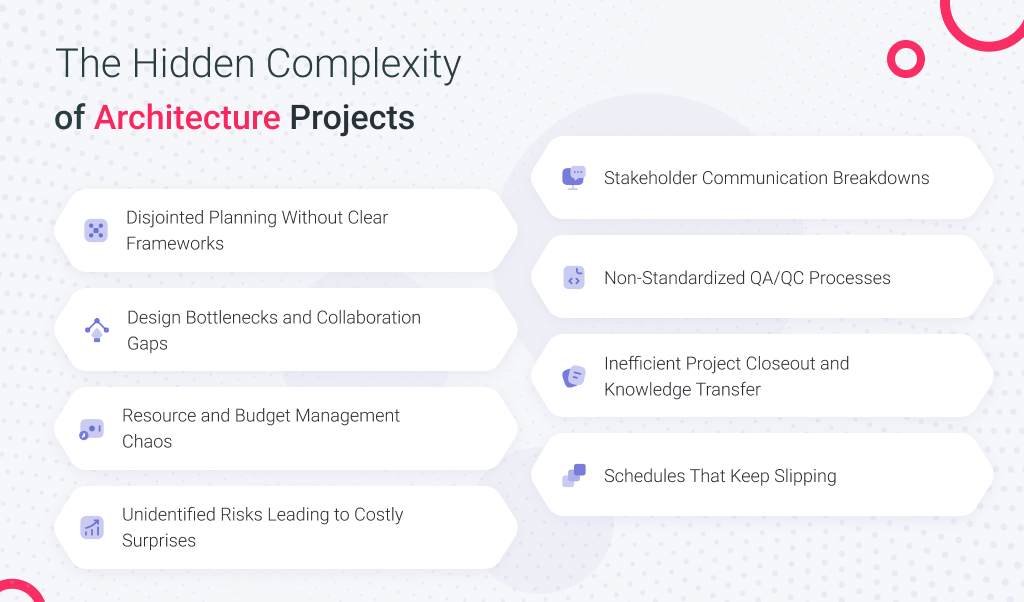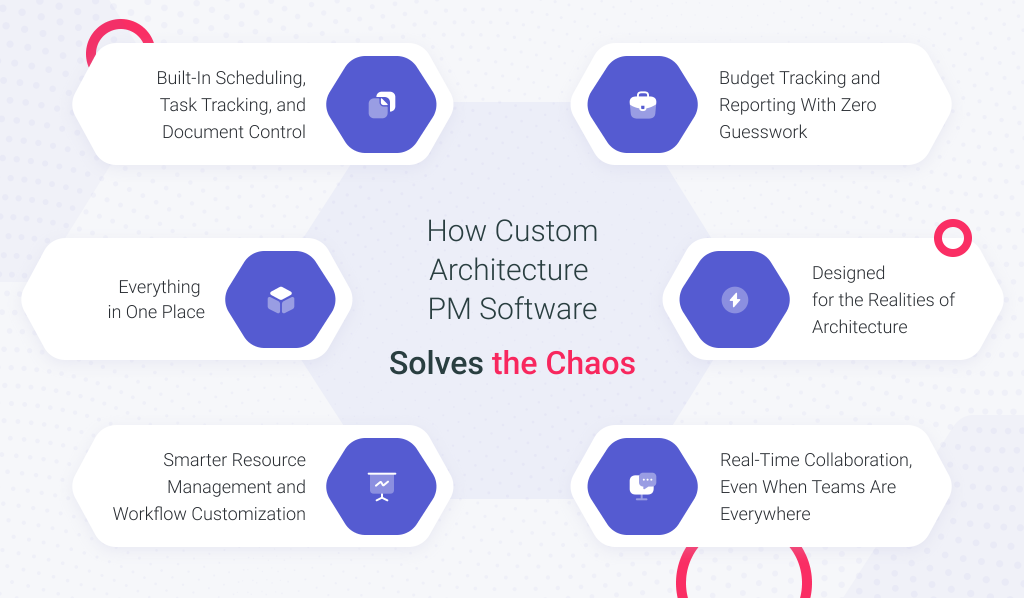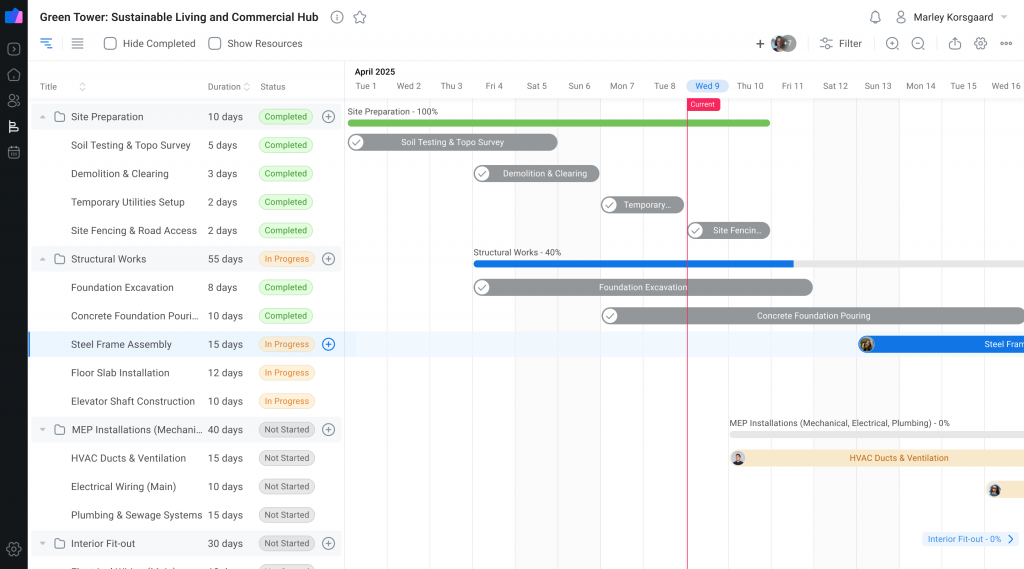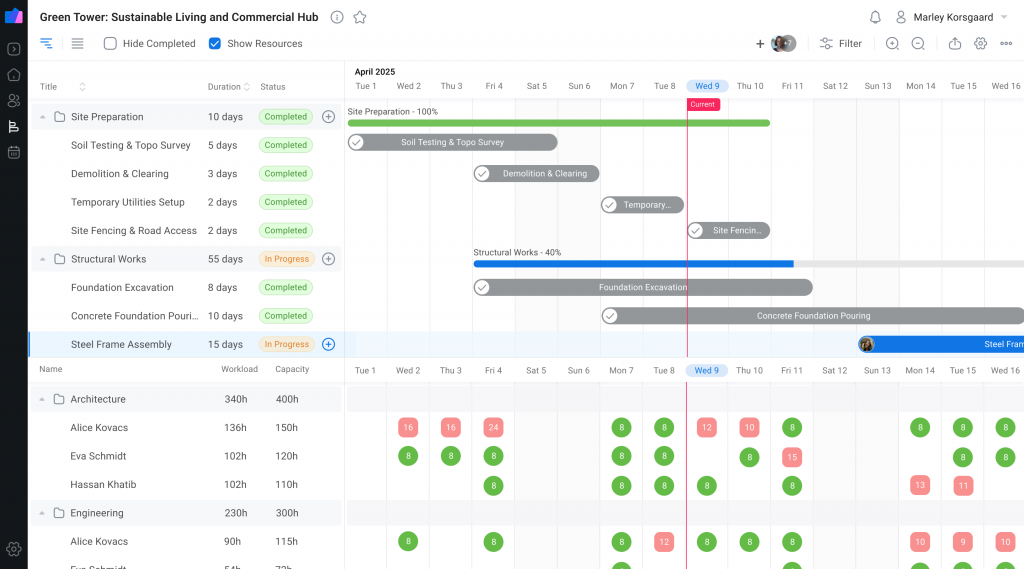Summary
This article examines how architecture firms confront hidden operational complexities—from misaligned stakeholder expectations to scheduling gaps and budget risks—and shows how a tailor-made project management system addresses them. It illustrates how custom software brings all project data, tasks, documentation and resources into one unified hub, enabling smarter scheduling, clearer collaboration and better risk mitigation.
Managing complex architectural projects with dispersed teams presents distinct challenges. Traditional project management methods often lack real-time visibility, efficient resource allocation, and seamless collaboration. Transitioning to custom project management tools is not merely a trend but a strategic move to enhance decision-making, mitigate risks, and scale operations effectively. Whether overseeing multi-phase residential developments or coordinating with remote stakeholders, architecture firms that invest in tailored software solutions can optimize workflows, deliver superior results, and gain a competitive edge.
In this article, we’ll delve into why custom project management systems are becoming essential for modern architecture firms and explore key features that drive efficiency.
The Hidden Complexity of Architecture Projects

Architecture firms don’t just design buildings. They’re involved in an intricate combination of creativity, compliance, collaboration, and coordination. Whether managing boutique residential builds or large-scale commercial developments, architects often find themselves stretched thin trying to juggle design brilliance with logistical reality. Let’s consider the most common challenges that architects face.
- Disjointed Planning Without Clear Frameworks. Some firms begin projects without a centralized system for setting goals, central repository for the Owner’s Project Requirements (OPR), or aligning stakeholders. Other common issues include the absence of a clear project charter or BIM Execution Plan (BEP). This lack of clarity early on often leads to budget overruns and misaligned expectations down the line;
- Design Bottlenecks and Collaboration Gaps. The design process is rarely linear. Project teams often struggle with version control, miscommunication between architects and consultants (MEP, structural, civil), lack of a Common Data Environment (CDE), or feedback delays that stall momentum. Without streamlined collaboration, even the best designs can get stuck in limbo;
- Resource and Budget Management Chaos. Allocating the right people and materials at the right time is easier said than done. Teams that work off outdated spreadsheets or siloed systems are making it hard to track real-time costs or forecast resource needs. Lack of earned value management (EVM) or dynamic resource allocation tools often results in budget blowouts and staff burnout;
Read Also Dangers of Data Silos And Efficient Strategies for Eliminating Them
- Unidentified Risks Leading to Costly Surprises. From zoning complications to last-minute design changes or site surprises, architecture projects are full of uncertainties. Without a proactive risk mitigation approach and preliminary hazard analysis (PHA), firms find themselves reacting to issues instead of preventing them;
- Schedules That Keep Slipping. Meeting deadlines is critical for profitability and reputation, but schedule slippage is a constant threat. Delays in approvals, RFI (Requests for Information) responses, construction holdups, or miscommunication can derail even well-planned timelines. Without 4D scheduling integration or critical path method (CPM) tracking, firms risk client dissatisfaction;
- Stakeholder Communication Breakdowns. With so many stakeholders involved (owners, architects, engineers, contractors, and Authority Having Jurisdiction), it’s easy for messages to get lost, misunderstood, or mismanaged. Unstructured email chains, inconsistent RFI responses, and non-standardized submittal processes can lead to frustration, rework, and lost trust;
- Non-Standardized QA/QC Processes. As teams grow and projects scale, maintaining consistent quality becomes increasingly difficult. Absent standardized checklists, model validation protocols, or constructability reviews, errors propagate into construction documentation and field execution;
- Inefficient Project Closeout and Knowledge Transfer. Closing out a project should be a moment of celebration, but for many firms, it’s just another headache. Incomplete as-built documentation, O&M manual discrepancies, unresolved punch lists, and unclear handover processes drag out the final stages and distract from new opportunities.
How Custom Architecture Project Management Software Solves the Chaos

Now that we’ve unpacked the real-world challenges architecture firms face, let’s talk about the solution. Custom project management software for architects is not just another tool on the shelf. It’s a game-changing platform built specifically to handle the layered demands of architectural workflows. When you’ve got tight deadlines, shifting client needs, and a dozen moving parts on every project, having a centralized system is a necessity.
Everything in One Place
Architecture project management software brings clarity to the clutter. Instead of toggling between emails, spreadsheets, messaging apps, and Gantt charts scattered across systems, your entire project ecosystem lives in one unified hub. Designs, documents, communications, budgets, and timelines are all connected and accessible in real-time. No more chasing files. No more guessing who’s doing what. Just smooth, coordinated progress.
Smarter Resource Management and Workflow Customization
Your people and time are your most valuable assets. Good project management software helps you make the most of both. You can track time, allocate tasks based on capacity, and adjust workloads before bottlenecks slow you down. Plus, with customizable workflows, your team isn’t stuck adapting to rigid systems. You tailor the platform to match how your studio actually works.
Read Also How to Finish a Construction Project on Time, Within the Budget, and not Run Out of Resources
Built-In Scheduling, Task Tracking, and Document Control
Complex architect projects come with a mountain of details. With integrated scheduling tools, automatic task assignments, and centralized document storage, nothing slips through the cracks. Everyone knows what’s due, when it’s due, and where to find what they need to keep moving forward.
Budget Tracking and Reporting With Zero Guesswork
Architecture project management software helps you stay on top of costs with real-time budget tracking and forecasting tools. Detailed reports and dashboards give you a clear view of how projects are progressing and where your resources are going. This enables access to powerful data that lets you make smarter decisions and avoid costly surprises.
Designed for the Realities of Architecture
Custom architecture software is tailored to your world. It incorporates everything from managing design iterations to ensuring construction deadlines are met. In a manner, it’s a digital project partner that understands how your projects work.
Real-Time Collaboration, Even When Teams Are Everywhere
Whether your team is spread across studios or on-site at different locations, the custom project management software keeps everyone in sync. Real-time updates mean no delays, no double work, and no crossed wires. Designers, engineers, contractors, and clients can all stay on the same page.
Thinking of Building Custom Project Management Software? Here’s What You Need to Know
Custom-built software can be a game-changer, but only if it’s done right. As a software development partner, here’s how we help architecture firms build custom software solutions that actually make a difference.
Before a single line of code is written, we begin by understanding your firm’s strategic pain points. Are you struggling to manage change orders across multiple projects? Do you need tighter cost control? Or is design collaboration across remote teams your biggest hurdle? Whatever your goal is, our objectives shape the foundation of the build. And our team doesn’t follow any assumptions. We believe in alignment. Successful software solves real problems. That’s why we go straight to the source and communicate with the client to understand the target audience of the future software product. We collect the insights needed to map out user journeys and functional requirements. It helps us translate day-to-day frustrations into features that solve them. Read Also Where Is the Line Between Identifying Client’s Needs and Interrogating? No one wants another clunky system. Custom doesn’t mean complicated. We specialize in clean, intuitive user interfaces that mirror the logical flow of architectural work. Whether it’s project dashboards, timeline views, or drawing management tools, every screen is designed to reduce clicks and eliminate confusion. When software feels natural, adoption is easy. When it doesn’t? No one uses it. Depending on your needs, your architecture project management software might include: Read Also How Software Innovations Address Challenges in Various Types of Construction Projects XB Software leverages a robust and modern technology stack to develop custom project management applications tailored for the architecture industry. These solutions are designed to address the unique challenges faced by architectural firms. Front-End Technologies: Back-End Technologies: Architecture firms operate within a complex digital landscape, utilizing a variety of tools such as Building Information Modeling (BIM) software, accounting systems, and Customer Relationship Management (CRM) solutions. To ensure efficiency and coherence across these tools, our custom project management solutions are designed with robust integration capabilities. BIM Synchronization. We offer seamless synchronization with leading BIM software like Revit and ArchiCAD. This integration ensures that any changes made within BIM models automatically update corresponding tasks and schedules within the project management platform, maintaining consistency across design and planning phases. Ecosystem Integration. Our solutions support import and export functionalities with popular project management tools such as Asana, Trello, and Microsoft Project. API Access for Business Systems. We can implement integration with essential business systems, including accounting software like QuickBooks, CRM platforms such as HubSpot, and Enterprise Resource Planning (ERP) systems. This integration streamlines data flow, eliminates redundant data entry, and ensures that all departments operate with synchronized information. Software isn’t “done” the day it launches. Once your project management system is deployed, we enter a dedicated support and maintenance period. It’s our commitment to making sure everything runs smoothly. During this phase, we stay closely connected with your team to monitor performance, ensure operational stability, and resolve any issues quickly. To see how the right custom software can solve real challenges in the architectural workflow, let’s look at a case that mirrors what many architecture firms face: fragmented planning tools, poor task visibility, and inefficient resource allocation. Our client is a mid-sized US-based architecture firm specializing in highly regulated, large-scale projects across higher education, science & technology, civic & government and healthcare sectors that demand strict compliance, multi-phase approvals, and seamless coordination with engineers, contractors, and stakeholders, making efficient project management critical. Major challenges our client faced include: The client requested to bring structure and clarity to the growing list of projects stored in Google Firebase. His teams struggled with siloed data, scattered task tracking, and no easy way to assign or manage resources. The client’s key requirements included: We designed and delivered a tailored architecture project management system, built with a strong emphasis on visualization, resource control, and ease of use. Thanks to the Webix JavaScript library, we were able to accelerate development by leveraging its extensive suite of ready-to-use UI widgets and complex components. Here’s how the key features solved our client’s challenges: Thanks to the implementation of the custom project management solution, the client’s architecture firm achieved significant improvements in efficiency, collaboration, and scalability. Here’s how the new system delivered measurable results: Read Also How Using Gantt Chart Can Change Your Understanding of Project Management Custom project management software emerges as a transformative solution, tailored to address unique pain points of architecture companies. By integrating and customizing Gantt chart visualizations, resource leveling, and cloud-based platforms, developers help architects achieve enhanced clarity, efficiency, and scalability in their operations. If your firm is grappling with similar challenges and seeking a solution that aligns with your unique processes and goals, we’re here to help. Contact us today to explore how we can support your journey toward optimized project management.
Use Case Example. Transforming Project Management With a Gantt Chart App
Our Solution: A Custom Webix Gantt Application for Architects


Results: How Custom PM Software Transformed the Client’s Workflow
From Blueprints to Breakthroughs: The Custom Software Advantage